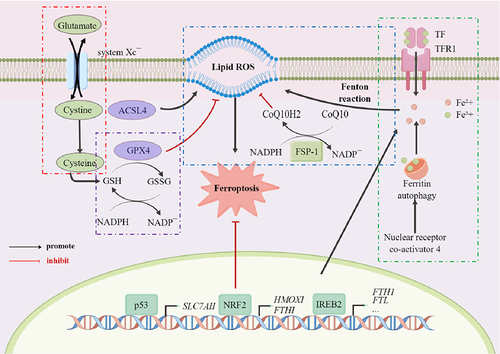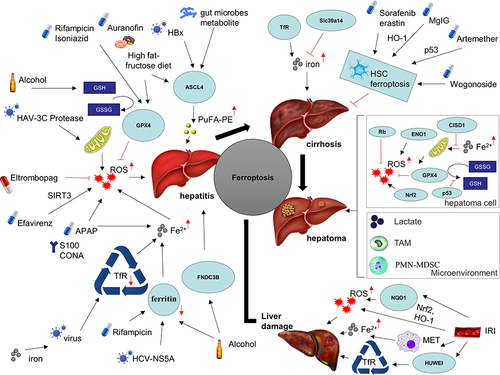Figures & data
Figure 1 Schematic illustration of the main mechanisms of ferroptosis.
Notes: The mechanism of ferroptosis is divided into the following parts, namely the transport of cystine (red box), the function of GPX4 (purple box), the transport of iron ions (green box), and the Fenton reaction (blue box). The first is the transport of cystine, which will be transported into the membrane by cystine/glutamate transferase, while glutamate will be transported out. After entering the membrane, cystine, first converted to cysteine, will then be with glutamic acid and glycine, forming reduced glutathione (GSH). GSH forms oxidized glutathione (glutathione disulfide, GSSG) via glutathione peroxidase 4 (GPX4). This process will assist GPX4 in removing the peroxidation of polyunsaturated fatty acids, which form plasma membrane oxygen radicals. At the same time, trivalent iron ions enter the cell membrane as ferritin through TFR1 and are reduced to divalent iron ions after entering the membrane. Divalent iron ions combine with a series of peroxides to produce the Fenton reaction, which in turn produces hydroxyl radicals with strong oxidative properties that promote lipid peroxidation and ultimately lead to the development of ferroptosis.

Figure 2 Ferroptosis in chronic liver diseases.
Note: Ferroptosis has been implicated in a variety of chronic liver diseases, including various etiologies of hepatitis, ischemic liver injury, cirrhosis, and liver cancer.
Abbreviations: HBx, hepatitis B virus X protein; HAV, hepatitis A virus; HCV, hepatitis C virus; ASCL4, achaete-scute family BHLH transcription factor 4; PuFA-PE, polyunsaturated phosphatidylethanolamines; GSH, glutathione; GSSG, oxidized glutathione disulfide; GPX4, glutathione peroxidase 4; ROS, reactive oxygen species; SIRT3, sirtuin 3; APAP, acetaminophen; CONA, Concanavalin A; TfR, transferrin; FNDC3B, fibronectin type III domain containing 3B; Slc39a14, solute carrier family 39 member 14; HO-1, heme oxygenase 1; MgIG, magnesium isoglycyrrhizinate; HSC, hepatic stellate cell; Rb, retinoblastoma gene; ENO1, alpha-enolase 1; CISD1, CDGSH iron sulfur domain 1; Nrf2, nuclear factor erythroid 2-related factor; 2TAM, tumor-associated macrophage cell; PMN-MDSC, pathologically activated neutrophils-termed myeloid-derived suppressor cell.

